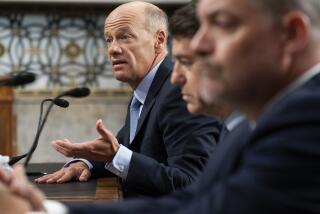Agencies Clash on Capital Reserve Rules : Banking: The FDIC wants a higher standard than the currency comptroller does. A Senate panel chairman tells them to agree--soon.
- Share via
WASHINGTON — Federal regulators clashed sharply before a Senate panel on Monday over how much capital banks should be required to hold in reserve, heightening the controversy over regulation of the increasingly troubled industry.
Comptroller of the Currency Robert L. Clarke said his office should have discretion to decide when individual banks need more money in reserve than a basic capital standard equal to 3% of assets.
But the comptroller’s plan drew a strong rebuke from Federal Deposit Insurance Corp. Chairman L. William Seidman, who favors a plan requiring virtually all banks to meet a capital standard of about 4.5% of assets. Seidman argued before the Senate Banking Committee that Clarke’s proposal actually represented a weakening of current standards and would be dangerous at a time when banks are already under pressure.
“Under no circumstances should we indicate to 10,000 banks that their capital can be reduced,” Seidman said. Many of the nation’s smaller banks, closely supervised by regulators, have capital far above both the current standard and the one proposed by Clarke.
The current standard requires banks to have capital equal to 6% of their assets, but the rule allows goodwill--the intangible value of a firm--to be included. Financial regulators have agreed that a new standard should restrict what could be counted as capital to such assets as cash and government securities.
Clarke argued that given the more limited definition of what counts as assets, the 3% requirement represents a sufficient strengthening of standards.
The dispute between Clarke, who oversees banks with national charters, and Seidman, who provides the insurance that guarantees deposits up to $100,000, irked the committee chairman, Sen. Donald Riegle Jr. (D-Mich.).
“I would like to see this settled in the next 30 days, if possible,” he told a panel of regulators, including Clarke, Seidman and Federal Reserve Board Governor Wayne D. Angell. “We’ve got to get this settled.”
The insurance fund protecting bank deposits “is under very severe stress and has been for some time,” Riegle said. “The reserve is dropping, and there is a hollowing out of real estate values region by region. I don’t think we can fool around longer with the capital issue unsettled,” he said.
Capital represents the money contributed to a financial institution by its owners. It represents a bulwark against the kinds of risky and frivolous investments that drove hundreds of savings and loan associations into insolvency during the 1980s. With little of their own money at risk, many S&L; owners invested recklessly, knowing that federal insurance would bail out depositors in case of disaster.
Strict capital standards could avert a repetition of the disastrous experience, Congress decided last year when it wrote the S&L; rescue legislation. New S&L; standards were required by the law.
But new bank standards have yet to be decided.
“Capital is the key to safety and soundness of the banking system,” Riegle said, urging the regulators to settle a disagreement that has raged for nearly a year.
“We’re dealing with thousands of supervisors and banks; they need a clearly defined standard,” said Seidman. Although he originally favored a 4.5% requirement for all banks, he has agreed to accept a Federal Reserve Board proposal calling for a standard of 3%, plus an additional amount for all banks except a handful awarded the top safety rating by regulators. In practice, this would mean virtually all banks would need capital close to Seidman’s original proposal of 4.5%.
“Everyone knows we need more of a capital cushion,” Fed member Angell told the committee. The 3% standard “may not provide as much protection as we need for a banking system entering a stress period,” he told the committee.
Clarke, by contrast, said that 3% should be acceptable, and that his office would decide on a case-by-case basis when to go higher. “We all embrace 3%; what is at stake is how we implement it,” he said.
But Seidman rejected the notion of giving the comptroller wide discretion, saying: “It’s absolutely essential we agree on capital standards. That’s no way to run a government.”
“We’ve come up with everything we could to accommodate Mr. Clarke,” Seidman said. He told reporters after testifying that he was “mystified” by Clarke’s insistence on the 3% standard.
Clarke said it was “misleading” for Seidman to suggest that thousands of banks would be permitted to reduce their capital under his plan. “We will not allow them to operate at the minimum” standard, Clarke told the committee.
More to Read
Inside the business of entertainment
The Wide Shot brings you news, analysis and insights on everything from streaming wars to production — and what it all means for the future.
You may occasionally receive promotional content from the Los Angeles Times.










